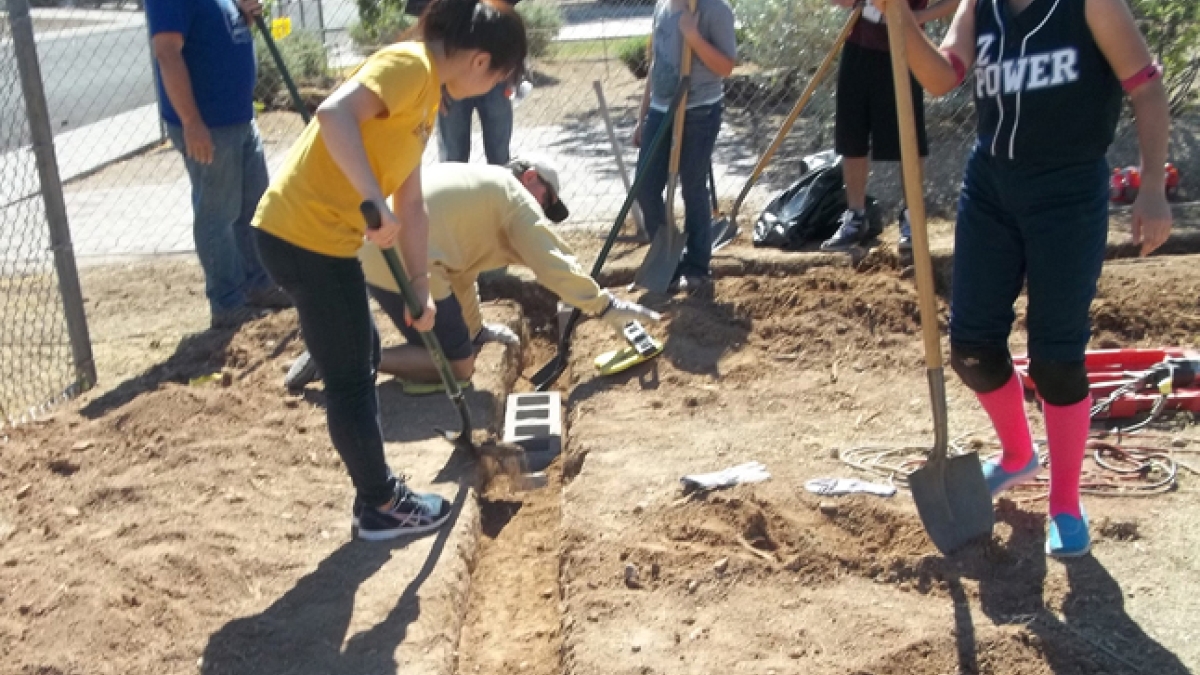School children experience nature with professor's help

Children and nature were meant for each other. That’s the philosophy of Arizona State University faculty member Pamela Marshall, who has combined her knowledge and love of science with her expertise in grant writing and curriculum design to help bring kids at a Glendale, Ariz. school into closer contact with their desert environment.
Marshall, an associate professor in ASU’s New College of Interdisciplinary Arts and Sciences, has a daughter who attends Copperwood Elementary School in the Peoria Unified School District, where an earlier effort by parents, teachers, administrators and the community resulted in the creation of a schoolyard habitat featuring native plants and a pond. The habitat, completed in 2010, was the brainchild of fellow Copperwood parent Janet Sharkey.
Now, thanks to a Heritage Fund grant from the Arizona Game and Fish Department and the hard work of countless volunteers and supporters, the site has expanded to include an outdoor environmental education classroom and desert tortoise habitat.
Marshall and Sharkey were co-principal investigators for the Heritage Fund grant.
“When my daughter was invited to attend the Copperwood Center for Differentiated Instruction gifted program in 2011, I emailed the Parent, Teacher, Student Association to see if they had anything I could do,” Marshall said. “I’m not interested in activities like organizing bake sales, but I told them I did write grants. I was contacted by Janet, and we met and planned to write some grants. At that time, there were none available, so we waited until 2012 when the Heritage Fund was available again.”
The original impetus for the project began in 2008, when Sharkey attended a parks and recreation conference with the theme of “No Child Left Inside.” She went to a “Be Outdoors Arizona” (BOAZ) session that included a group of advocates who were determined to spread the BOAZ mission of encouraging continuous nature-centered outdoor experiences that enrich the lives of children.
“I was inspired by the entire concept of getting our children outdoors to experience nature through hands-on exploration,” Sharkey said. “Our children are not interacting and learning about the environment in the same way we did when we were young – and therefore are not going to pass on their love of and the importance of interacting with nature to their children.”
In November 2013, a group of community partners and volunteers, including New College students, developed the classroom site, installed irrigation, plants, a tortoise burrow/area and fencing, and upgraded the pond in the existing area. Then, in January, project participants installed benches and connected the two sites with the arbor.
The final step was to install the tortoise habitat enclosure walls made of polymer concrete from Germany. The wall system, which was donated, has never been used in the United States, and is usually installed as part of a roadway near a wildlife crossing area. New College’s Service Learning Leaders assisted with trenching for the tortoise site.
Marshall is currently developing curriculum for the outdoor classroom; Copperwood teachers will be able to start using it this fall. Ecology Explorers from ASU’s Global Institute of Sustainability have offered to participate in the curriculum development effort, and Marshall also may turn to her colleagues in New College’s School of Mathematical and Natural Sciences to create age-appropriate curriculum for elementary school students.
“Indoor bench experiments are expensive, but studying the natural world is cheap. Engaging students in research, even as kindergartners, helps keep kids interested in science,” Marshall said. “Getting kids outside helps to calm them down, getting them to explore nature helps them to connect with the earth, and having a site like this allows them to do science experiments as well.”
Marshall is committed to inspiring students of all ages to develop and pursue a love of science. She engages undergraduate students in her laboratory research and won the 2008 ASU Faculty Achievement Award for Excellence in Student Mentoring. Since coming to ASU’s West campus in 2003, she has mentored more than 70 undergraduate students, many of whom have gone on to medical school.
Marshall’s research interests include experiments involving a yeast vacuole that is roughly equivalent to the lysosome in the cells of mammals. There are many human disorders in which lysosomal function is impaired, including Tay-Sachs disease, Krabbe disease, certain forms of cancer and some types of coronary artery disease. She is also part of an interdisciplinary team, with New College colleagues Carl Wagner and Peter Jurutka, to synthesize and evaluate novel RXR agonists and antagonists for treatment of cancers and Alzheimer’s disease.
The life sciences program for which Marshall teaches offers B.A. and B.S. degrees. Students may choose to pursue life sciences degrees with a pre-medical track or with optional concentrations in environmental science or forensics, or pursue a B.S. in forensics. Other degree offerings from the School of Mathematical and Natural Sciences include applied computing, applied math and statistics.